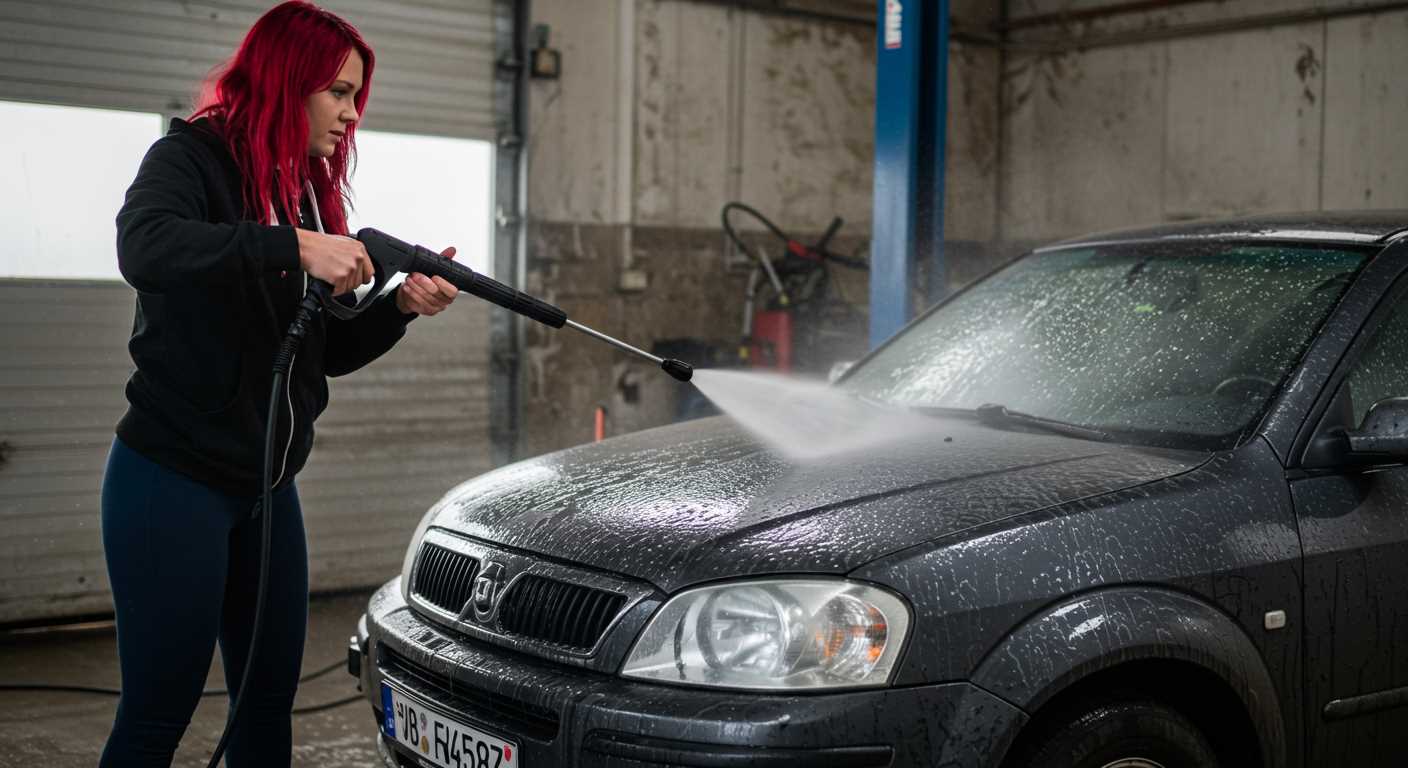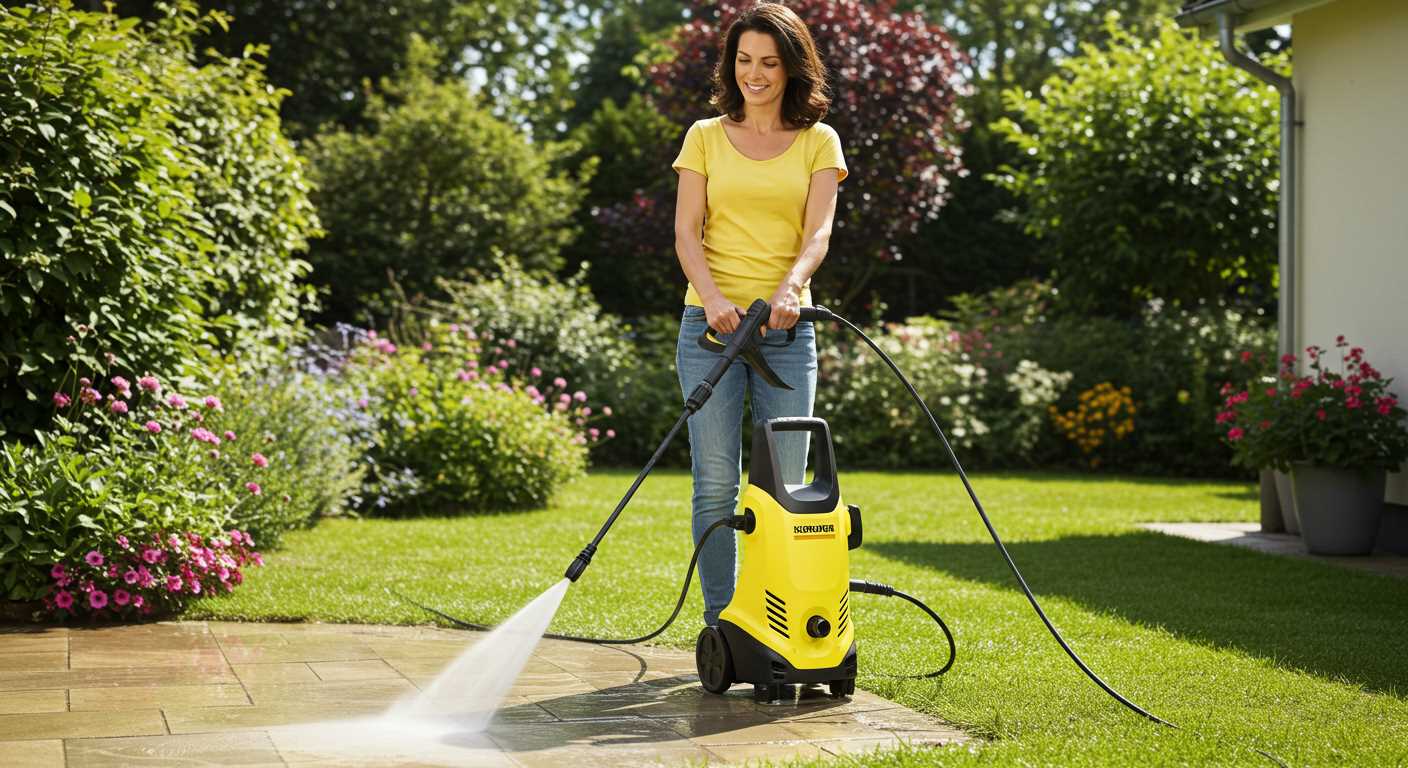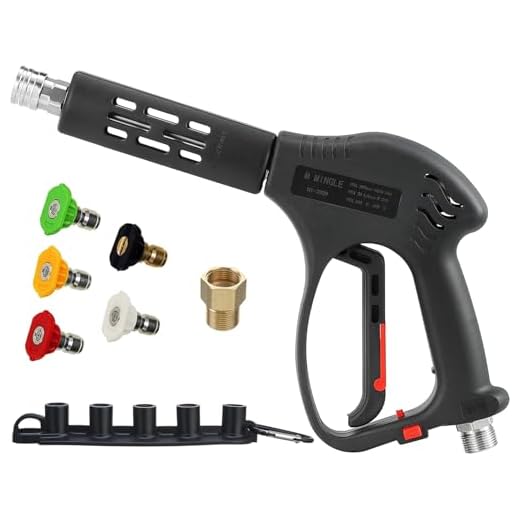

For optimal results on wooden patios, I recommend a wide-angle attachment, specifically a 25-degree model. This choice strikes the perfect balance, providing sufficient power to lift dirt and grime without damaging the delicate wood surface.
When tackling tough stains or mildew, consider using an adjustable spray pattern. This versatility allows you to switch between a concentrated stream for tougher spots and a broader spray for regular cleaning, enhancing efficiency in every session.
Considering the surface material is critical; if your outdoor area consists of composite materials, a 40-degree option may be more appropriate. It ensures a gentler clean while still being effective against mildew and dirt.
Always maintain a safe distance of at least 12 inches while operating any attachment to prevent any unintended surface damage. Knowledge of the cleaning power and recommended pressure setting can further refine your approach, ensuring both safety and cleanliness.
Recommended Attachment for Cleaning Patios
For optimal results when cleaning patios, I advise using a 25-degree tip. This attachment strikes a balance between pressure and coverage, allowing efficient removal of dirt and grime while minimising the risk of damage to the surface.
Benefits of a 25-Degree Tip
- Effective for general cleaning tasks, including algae and moss removal.
- Wider spray pattern enhances coverage, reducing the time spent on cleaning.
- Gentle enough for most surface materials such as wood and composite.
For stubborn stains or heavily soiled areas, consider switching to a 15-degree tip. This offers a concentrated stream, providing greater cleaning power for tough spots.
Tip Selection Tips
- Assess the surface type before choosing an attachment: softer materials need less pressure.
- Test on a small, inconspicuous area first to ensure no damage occurs.
- Regularly clean the tips to maintain superior performance.
Always wear protective gear, as high-pressure water can lead to injuries or slipping hazards. Investing in a quality attachment can significantly enhance your cleaning experience.
Understanding Nozzle Types for Deck Cleaning
To achieve optimal cleaning results, opt for a 25-degree or 40-degree spray tip. The 25-degree option offers a balance between pressure and coverage, effectively removing dirt without damaging the surface. Conversely, the 40-degree tip spreads water over a broader area, suitable for more delicate materials.
Angle Ratings
Cleaning attachments come with angle ratings, usually ranging from 0 to 40 degrees. A 0-degree attachment delivers a concentrated stream ideal for stubborn stains, yet should be approached with caution to avoid causing harm. For general cleaning tasks, the 25-degree type strikes a fine balance, while the 40-degree variant works well for sensitive or sealed surfaces.
Material Considerations
.jpg)
Different surfaces demand different attention. For composite woods, a wider angle helps to preserve the texture and prevent splintering. Meanwhile, hardwood often tolerates a narrower spray for tougher cleaning jobs. Always assess the material composition before selecting the appropriate attachment, ensuring the cleaning action aligns with the surface’s durability.
Choosing the Right Spray Angle for Your Deck

For effective cleaning, I recommend using a 25-degree fan pattern. This angle strikes a balance between power and coverage, suitable for removing dirt and grime without risking damage to the surface. Steer clear of narrower angles, such as 15 degrees, which are more suited for stubborn stains and can splinter wood if used aggressively.
Understanding Spray Angles
Different angles serve various purposes. A 0-degree pencil jet offers intense pressure over a small area, ideal for tough spots but too harsh for expansive surfaces. The 40-degree wide fan is gentle and great for rinsing or clearing debris. However, its effectiveness in deep cleaning is compromised. The 25-degree angle excels in versatility, making it the best option for most deck materials.
Tips for Optimal Performance
| Angle | Best Use | Surface Suitability |
|---|---|---|
| 0 Degrees | Spot cleaning | Concrete, tough stains |
| 15 Degrees | Heavy-duty cleaning | Stained concrete |
| 25 Degrees | General cleaning | Wood, composite, concrete |
| 40 Degrees | Rinsing | Delicate surfaces |
Ensure you’re consistently moving the lance while cleaning to avoid etching into the material. Adjust the distance between the sprayer and the surface based on the pressure and angle to prevent damage. The 25-degree option, when used correctly, delivers excellent results across multiple materials, maintaining the aesthetics of your outdoor space.
Matching Nozzle Size to Pressure Washer Specifications
Selecting the right size for the cleaning sprayer is critical for optimal outcomes. Always check the specifications of the cleaning apparatus, particularly the maximum pressure and flow rate. For example, if your device operates at 2000 PSI with a flow rate of 1.8 GPM, aim for a sprayer that complements these parameters. A 25-degree orifice may suit a medium range well, balancing force and coverage.
When dealing with tough stains or heavy build-up, a narrow orifice, such as 15 degrees, delivers a more concentrated stream capable of removing debris effectively. Conversely, for routine maintenance or light surface cleansing, a wider option around 40 degrees provides gentle coverage, reducing the risk of damage to surfaces.
Adjusting based on the surface material is also essential. Wooden structures can be sensitive to high pressure; therefore, opting for a milder orifice helps prevent splintering. In contrast, solid surfaces like concrete benefit from more aggressive pressure, allowing for thorough cleaning without concern.
In essence, pairing the size of the cleaning accessory with your machine’s specifications ensures both safety and efficiency. Take these factors into account and choose wisely to achieve effective results without compromising your surfaces.
How to Use a Nozzle Extension for Hard-to-Reach Areas
Start by ensuring compatibility between the extension and your cleaning machine. Attach the extension securely to the lance to prevent leaks or detachment during operation.
Identify the areas that require attention. These may include eaves, overhead fixtures, or tight corners. The extension allows you to address these surfaces without the need for climbing or extensive manoeuvring.
Adjust the angle of the extension to achieve optimal reach while maintaining a steady trajectory. This technique will help avoid unwanted splashing or damage to adjacent surfaces.
Select a compatible spray tip that suits your task. A zero-degree setting is ideal for concentrated cleaning, while a wider angle may be suitable for larger surfaces. Test the flow in a less visible area to gauge effectiveness before proceeding with visible sections.
Maintain a consistent distance from the surface. Holding the lance too close can result in damage, while being too far may reduce cleaning efficacy. A distance of 12-24 inches generally provides an ideal balance.
Utilise sweeping motions rather than a static approach. This method distributes the cleaning power evenly and prevents streaking, ensuring thorough treatment of the area.
Once finished, detach the extension carefully, allowing any residual water to drain away. Store both the extension and your cleaning device properly to prolong their lifespan.
Identifying the Best Nozzle Material for Deck Surfaces
For optimal results when cleaning outdoor surfaces, selecting the right material is key. A high-grade brass or stainless-steel model offers durability and resistance to wear, making them superior choices for various tasks.
Recommended Materials

- Brass: Tolerates high pressures and is resistant to corrosion. Ideal for regular use over time.
- Stainless Steel: Provides excellent strength, ensuring longevity and performance, particularly in harsher environments.
- Plastic: Generally lighter and less expensive, but may wear out more quickly than metal options. Best for occasional tasks.
Material Performance Considerations
When assessing materials, consider the following:
- Longevity: Metal variants tend to outlast plastic, so investment in sturdier options often pays off.
- Pressure Compatibility: Brass and stainless-steel are capable of handling higher pressure levels, crucial for thorough cleaning.
- Corrosion Resistance: In areas with high moisture, corrosion-resistant materials are preferable to ensure functionality over time.
Testing various materials in real-world conditions has shown that while plastic can be viable for light jobs, investing in metal types significantly enhances performance and reduces the frequency of replacements. Select wisely to maximise efficiency and satisfaction in your cleaning endeavours.
Adjusting Pressure Settings According to Nozzle Type
Selecting appropriate pressure levels is crucial for achieving optimal results while maintaining the integrity of surfaces. For wider spray angles, such as 25° or 40°, I recommend reducing the pressure setting to prevent potential damage. A lower pressure ensures that even delicate materials won’t suffer from excessive force during cleaning.
Specific Pressure Recommendations
For a fan spray around 25°, setting the pressure between 1400 and 1600 psi is generally effective. This range strikes a balance, allowing efficient cleaning while protecting wood fibres. If engaging a 15° spray, feel free to increase the pressure up to 2000 psi; however, maintain a safe distance to mitigate any risks associated with concentrated spray patterns.
Maintaining Safe Distances
It’s essential to consider the distance from the surface when adjusting pressure. Directing a tighter stream too close can cause unwanted etching or stripping. For most cleaning applications, maintaining a distance of at least 12 to 18 inches will help safeguard against damage while still offering a thorough clean.
Maintenance Tips for Pressure Cleaning Attachments
Regular inspections are vital. Check for blockages caused by debris or grime that can lead to uneven performance. Ensure that the water inlet is clear to maintain a consistent flow.
Always clean the head after each session. Rinse with plain water to remove any cleaning solutions or residues. A soft brush can help dislodge stubborn particles stuck within the apertures.
Inspect for wear and damage. Look closely for cracks or loose fittings, as any compromise can affect the spray pattern and pressure output. Replace any worn components to ensure optimal results.
Store attachments in a dry location. Humidity can degrade materials over time. Keeping them in a protective case or container can extend their lifespan.
Use compatible accessories. If choosing to upgrade or replace parts, ensure they match the specifications of your equipment. Mismatched components can lead to operational issues.
| Task | Frequency | Notes |
|---|---|---|
| Inspect for blockages | Before each use | Clear any debris to ensure smooth operation. |
| Clean head | After each use | Rinse with water and use a soft brush if needed. |
| Check for damage | Weekly | Replace any broken or worn components. |
| Store properly | After each session | Keep in a dry place to prevent degradation. |
| Check compatibility | When replacing parts | Ensure they are suitable for your equipment. |








